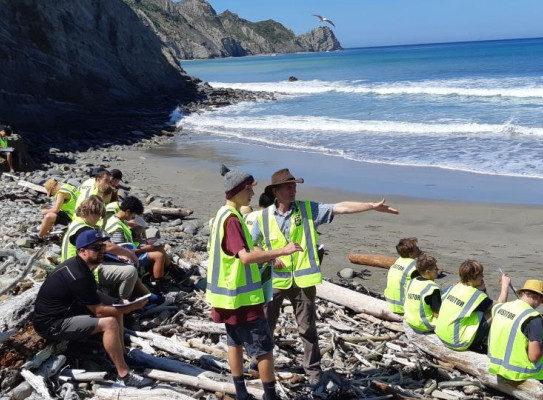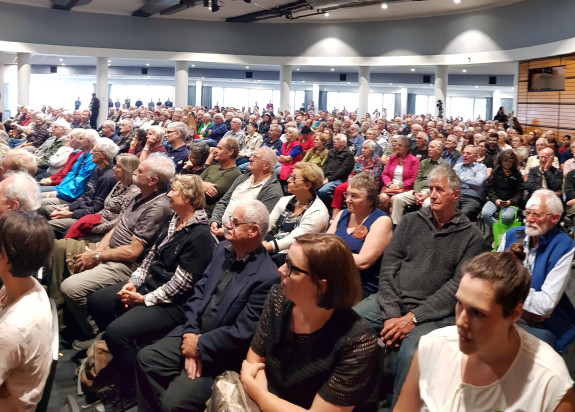
Our research is galvanising community action

Like a sleeping giant, Aotearoa New Zealand’s largest and most active fault, the Hikurangi subduction zone, lies off the east coast of the North Island.
It’s where the Pacific tectonic plate dives beneath the east coast. A rupture could produce large earthquakes and tsunamis. A significant event could strongly impact our largest population centres including Auckland, Wellington and Christchurch.
High-impact research into the zone’s behaviour is yielding invaluable information for more reliable forecasts of the hazard and risk which the zone poses to Aotearoa New Zealand.
One of the research team’s leaders is geophysicist Dr Laura Wallace from GNS Science. She says the main aim is to drive better community preparedness in the event of a rupture.
Since 2016, we have been leading several onshore and offshore projects investigating the behaviour of the Hikurangi subduction zone. Much of this is being supported under a five-year MBIE-funded Endeavour programme.

https://www.youtube.com/watch?v=Zm1fHWLFjWY – East Coast LAB - The Hikurangi subduction zone transcript
https://www.youtube.com/watch?v=Zm1fHWLFjWY
A large Hikurangi subduction zone earthquake and tsunami- it's not a matter of if, but when. This video explores what the Hikurangi subduction zone is, how scientists, emergency managers and other experts are planning for it
This work is advancing our knowledge about the earthquake potential of the plate boundary and the physical processes behind it
Since 2016, we have been leading several onshore and offshore projects investigating the behaviour of the Hikurangi subduction zone. Much of this is being supported under a five-year MBIE-funded Endeavour programme.
“This work is advancing our knowledge about the earthquake potential of the plate boundary and the physical processes behind it,” says Dr Wallace.
To share our findings and build public awareness and resilience, we have partnered with East Coast Life at the Boundary (LAB). This programme brings together scientists, emergency managers and other experts, with communities along the North Island’s East Coast.
This past year we invested considerable effort in public engagement and education. Our scientists joined with NIWA and East Coast LAB to present talks in 11 communities in the North Island, reaching more than 1100 people.
“They have also been involved with school fieldtrips and educational visits to East Coast schools when undertaking fieldwork in the region," Laura says.
We hope this will help inspire the next generation of scientists.”
The Hikurangi subduction zone research programme involves deep partnerships with international research institutions. These have helped advance this country’s reputation as a focal point for the investigation of subduction plate boundary processes, leading to an unprecedented NZD$70 million of international investment in projects to understand the Hikurangi subduction zone. For example, Aotearoa New Zealand has been chosen as one of three global focus sites for subduction zone research under the US National Science Foundation GeoPRISMS programme.

This year, GNS Science also embarked on a new project with Japanese collaborators investigating the parallels between subduction zones in northeast Japan and Aotearoa New Zealand, led by Dr Dan Bassett. A key aim is to compare the causes of earthquakes on both subduction zones and shed light on the types of future earthquakes the Hikurangi fault may produce.
In another project, led by Dr Grant Caldwell, scientists from GNS Science and Tokyo Institute of Technology, in collaboration with Chorus Ltd, used the underground copper wire telephone network to measure small changes in the Earth’s natural magnetic and electrical fields at sites across the Gisborne region. The novel measurement technology can be used to better monitor physical changes inside the fault, and improve understanding of the earthquake and tsunami risk to the East Coast.
Our collaborators
The Hikurangi subduction zone programme is a multi-disciplinary collaboration between GNS Science, NIWA, Victoria University of Wellington, Canterbury University, the University of Auckland, East Coast Life at the Boundary (LAB), and iwi/taiwhenua partners. There is also an extensive network of international collaborators in the United States, Japan, the United Kingdom and Europe.
The importance of this research is immense. It has galvanised action across civil defence and emergency management groups along the East Coast
"It brings together emergency managers and scientists together to better understand the information needed and the key interdependencies to plan for something our communities have never experienced. Understanding this risk enables our communities to identify potential consequences ahead of time. This allows us to better anticipate what might happen in the future, to help minimise losses and, we hope, ultimately it will save lives," says
